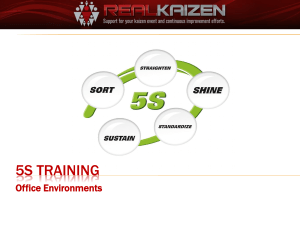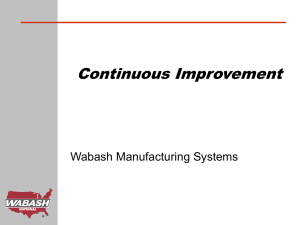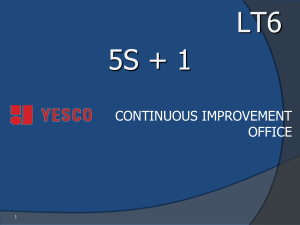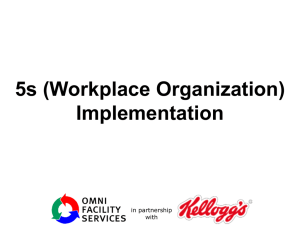5S Presenter - Ohio Manufacturers' Association
advertisement
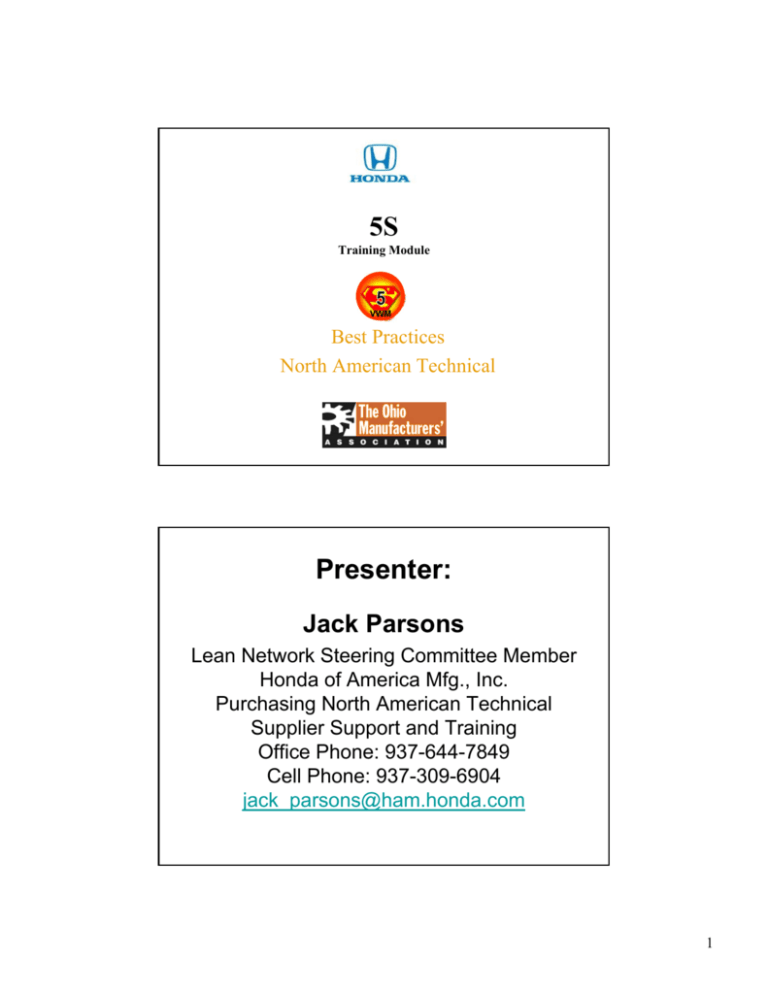
5S Training Module VWM Best Practices North American Technical Presenter: Jack Parsons Lean Network Steering Committee Member Honda of America Mfg., Inc. Purchasing North American Technical Supplier Support and Training Office Phone: 937-644-7849 Cell Phone: 937-309-6904 jack_parsons@ham.honda.com 1 5S – Workplace Organization By: Soichiro Honda The reason why I tell you, Honda employees, to keep our factory clean is not to look good from the outside. A mindset which neglects a dirty and unorganized factory will never generate excellent products. Our factory is where we all live. Those who have no mindset to organize this place will never be able to build excellent products. Our mindset is directly reflected in our products. WORKPLACE ORGANIZATION (5S) Seiri = Sort Eliminate unnecessary Items Seiton = Set In Order, Organize & Identify Seiso =Shine Clean/Inspect routinely Seiketsu = Standardize, Create Visual Standards Shitsuke = Sustain Establish good Habits Introduction and Agenda 5S • • • House of Continuous Improvement / Lean What is 5S ? 5S Training and Audit 2 House of Continuous Improvement and Lean Continuous Improvement & Lean Pulling Products Point of Use Storage Innovation Flexibility Quick Changeover Continuous Flow Improved Parts Presentation Total Productive Maintenance Error Proofing Associate Involvement The mortar represents the Company’s culture Value Standard Work 5S / VWM Stream Mapping What is Standard Work? Most efficient work flow Considering Safety, Quality, Delivery and Cost The main focus is on human movements (Ergonomics, Safety & Efficiency of Movements) Eliminate the Dirty, Dangerous and Difficult 5S & Standard Work 8/9 6/7 5 10 4 1 2/3 • Takt Time (Customer Demand) • Standard Work Sequence and Cycle Times • Standard Material Levels & Placement 5S should be an Integral Part of Standard Work OR we are Just Straightening Up and Cleaning the Waste 3 Characteristics of The Visual Workplace “Communications Open and Visual” Visual Control “Simplicity, Concentration & Speed” Visual Display Workplace Organization Standard Work (Based upon a 5S Culture) “The Ability to see the Abnormal Condition Immediately” Characteristics of the Visual Workplace Workplace Organization & 5S Visual Control Visual Display Workplace Organization (Based on 5S Culture) 4 Introduction to 5S • What is 5S? • Getting Started • Sort • Set in Order • Shine • Standardize • Sustain • Getting the Most Out of the 5S’s What is 5S? • A systematic method to organize the workplace, to keep it neat and clean, to maintain standardized conditions, and to sustain the discipline that is needed for high performance. • The 5S system should come first as a basis for other improvements. 5S identifies where the problems are. – 5S is a great way to eliminate waste. – 5S is a culture. It must be taught then used repeatedly to become part of everyone’s daily routine. 5 Implementing and Sustaining a 5S program takes a major Culture Change. Does anyone look familiar ? Do you have “CAVE” Men or Women in your company ? 6 itizens gainst irtually verything The 5S System Japanese -- English Terms Seiri -- Sort Seiton -- Set in Order Seiso -- Shine Seiketsu -- Standardize Shitsuke -- Sustain 7 The 5S System 1: Sort - Eliminate unnecessary items. 2: Set in Order - Organize and Identify. 3: Shine - Clean / inspect routinely. 4: Standardize - Create visual standards. 5: Sustain - Establish good habits. Sort Sustain Continuous Set in Order Improvement Cycle Standardize Shine The Importance of 5S •Safety Practices •Productivity Efficiencies •Quality Assurance Mistake Proofing Process Controls •Equipment Reliability (TPM) •Flexibility (short lead time) One-piece-flow Quick set-up •Better work environment Safety Quality Cost Delivery Morale Symbol -Identifies Benchmark process 8 Benefits of the 5S System • Improves • Reduces – – – – – – Waste Downtime Defects Changeover time Delays Questions – – – – – – Safety Customer satisfaction Personal satisfaction Visual Control Standardization Process Control Introduction to 5S • What is 5S? • Getting Started • Sort • Set in Order • Shine • Standardize • Sustain • Getting the Most Out of the 5S’s 9 Getting Started • Prior to starting a 5S implementation project, planning and preparation must take place. • Laying the groundwork: – Explain the overall concepts and objectives of 5S to upper-level management in the plant. – Get upper-level management support. – Select target area(s) – Choose a project facilitator for each target area. – Ensure that you have the target area management’s support, including resources. Getting Started • Form a core implementation team to manage 5S implementation in target areas. – People who are interested / willing to participate. – Represent the different job functions in the area. – Area manager must support each member’s involvement. – Each team member must understand scope of project. – Communicate 5S concepts and plan to all Associates. 10 Getting Started Introducing 5S to associates. (flyers, banners etc.) 5S Implementation Schedule: (Target Area Example) Item Months Week 1 2 3 4 5 6 7 8 9 10 11 12 13 14 15 Preparation Getting Started Workplace Scan Sort Set in Order Shine Standardize Sustain Notes: 1. Each S may take several months to implement but perfecting the process never ends 2. The 5S system will expand into other areas after the initial area is complete. 11 Sort / Seiri Identify what is needed and not needed right here, right now Set items aside for group disposition Dispose of items: Find a better location in the work area Locate elsewhere in the facility Sell, give away, or throw away 5S Red Tag Sorting Items from the Workplace Level Low Degree of Need (Frequency of Use) Average High Storage Method (Stratification) Things you have not used in the past year or won’t be needing Things you have only used once in the past 6-12 months Throw them out Store at a distance Things you have only used once in the last 2-6 months Things used more than once a month Store in a central place in the workplace Things used once a week Things used every day Things used hourly Store near the work site or carry on the person 12 5S Red Tag Red Tagging • Red tagging is a visible way to identify items that are NOT needed or in the wrong place. – – – – Establish the rules. Identify unneeded and misplaced items. Throw out items that have no use or value. Attach Red tags to items that are unknown or might be used outside of the work area. – Move tagged items to the Red tag holding area for temporary storage. – Communicate that items have been moved. 5S Red Tag Example • The red tag should include: – Description of item – Where & when tagged – Date – Reason tagged – Additional items for your situation 13 AEP Red Tag Holding Area Locate in highly visible area and close to Management. Here’s a Red Tag Area that’s easy to understand. Simple instructions posted on the board indicate how the area is to be used. 14 It’s amazing how much you can find! Central Red Tag Area at the Anna Engine Plant. Alternative Method of Red Tagging Red Tag NOT needed Dispose now. Yellow Tag We MAY need this. Keep it until _________Date • Allocate a central Red Tag area. • Include disposal instructions. • Appoint a review board for questionable items. • Allocate a Yellow Tag area close to workplace. • Review on specific date. • Store occasionally used items in out of the way locations. Green Tag • Leave Green Tag items in the workplace. We DO Need it. Keep it • Set their final location later in 5S process. 15 Introduction to 5S • What is 5S? • Getting Started • Sort • Set in Order • Shine • Standardize • Sustain • Getting the Most Out of the 5S’s Second S: Set in Order "A Place for Everything and Everything in its Place" • Organize and locate all necessary items. • Decide how many of each item will be stored in a given location (set height, size, and min/max inventory limits). • Make it easy for anyone to find and use them. • Make it obvious when they are not in their correct place. 16 Second S: Set in Order • Increases job efficiency by making it easier for anyone to find, use and return items. • Check points for your workplace: Are the positions of main corridors, aisles and storage places clearly marked? Are tools / office equipment divided into specialized use and “regular items?” Are all pallets always stacked to the proper heights? Is anything stored around fire extinguishers & eye wash stations? Are office areas / workstations clearly identified? Principles of Storing Jigs, Tools & Materials Locate according to their frequency of use Items used together should be stored together Right size storage areas Eliminate variety by using multi-purpose tools Use open storage systems Use Gravity to your advantage Make it obvious where things belong 17 5S Example: Organization Standard Work Shadow board Tool Belt 5S Example: Organization 18 5S Example: Organization Operator work station BEFORE Operator work station AFTER 5S Example: Organization Notes: • Everything has a place. • Shelves are built on an angle. • Items are identified with labels. • Work area is clean and organized. 19 5S Example: Organization Before After VWM 5S Example: Organization Organized Tool / Die repair area VWM 20 Establishing Boundaries Boundaries identify the designated location and space for each item. They encourage recoil, that is the proper placement and return of an item. These barrels should be here. A missing barrel is not obvious. Paint 101 Clearly something is missing. Thinner 200 Address tells us what is missing. Boundary lines designates proper location. Paint 101 Thinner 200 Paint 101 Thinner 200 Address on both barrel and location , encourages it’s proper placement and return. 5S Example: Organization Before After 21 5S Example: NO Organization Mold or Die Storage “Chaos” BEFORE 5S Example: Organized Maintenance area Area Identified Staging lanes Associate assigned 22 5S Example: Assembly aisle Identification 5S Example: Organized Traffic Flow Tow motor route controlled through floor markings. VWM 23 Introduction to 5S • What is 5S? • Getting Started • Sort • Set in Order • Shine • Standardize • Sustain • Getting the Most Out of the 5S’s Shine / Seizo • Thoroughly clean the overall workplace. • Clean workstations and equipment, inside and out. • Identify and eliminate sources of contamination. • Find ways to keep the workplace clean. • Make cleaning part of everyday work. • Adopt cleaning as a form of inspection. 24 Identify the source of contamination and eliminate it. No Band Aids ! Third S: Shine What’s wrong with this machine? …….… Now we can find out! Before After 25 Third S: Shine Before After Third S: Shine Before After 26 Third S: Shine • Restore items to like-new condition where possible. – Refurbish, paint, clean, polish, etc. • Plan cleaning assignments and cleaning methods. • Replace worn wires, hoses, etc. • Prevent dirt, grime and contamination from occurring. Benefits of Shine • Cleaning helps uncover problems “Inspection”. • Cleaner facilities support higher quality, higher precision and finer processing technologies. • Fewer equipment breakdowns because you spot problems/deterioration early. • A safer workplace with fewer hazards. • A more effective and satisfying place to work. 27 Inspection Through Cleaning Example: Difference between washing a car in an automatic car wash and washing it by hand. Overall, the car is clean either way But less obvious physical defects are revealed only by personal inspection of the various parts (tire wear-out, presence of nails, cracks in the finish, body scratches, rust, etc.) This type of cleaning through inspection of equipment in your area is important for the same reasons. Example of 5S Cleaning Duties 28 5S Supplies or Tools provided line side Cleaning kit and check sheet Supply storage board Designated location for cleaning supplies. VWM 5S Supplies or Tools provided line side Organized 5S cleaning supply station. Organized and labeled recycle and trash locations. VWM 29 VWM Introduction to 5S • What is 5S? • Getting Started • Sort • Set in Order • Shine • Standardize • Sustain • Getting the Most Out of the 5S’s 30 Standardize / Seiketsu • Determine standard procedures and make them visible. • Designate standard colors, shapes, and symbols to be associated with standard procedures. STOP Fourth S: Standardize • Implement the rules by which the first 3S’s are performed and maintained – Standardize Red tag procedures and Red tag holding area rules – Standardize location, number and position of all items (standardize colors, shapes, symbols, etc.) • Make temporary lines, signs, and labels permanent – Standardize cleaning schedules and procedures – Standardize work procedures and make visible 31 Fourth S: Standardize • Establish the standard conditions of Sort, Set in Order, and Shine. • Attain those conditions – Additional 3S work may be necessary to reach the standards you have set. • Make it easy (visual) to conform to standards. • Maintain and monitor these 5S conditions. – audits & tracking, daily follow up Fourth S: Standardize Color Coding for Floor Markings SIZE 3 INCH COLOR W HITE 2 INCH RED 2 INCH YELLOW 2 INCH GREEN 2 INCH BLUE 2 INCH BLACK 2 INCH ORANGE 2 INCH RED / W HITE 2 INCH YELLOW / BLACK 2 INCH W HITE / GREEN 2 INCH PURPLE PURPOSE AISLES, CONSUMABLES STORAGE, W ORK IN PROCESS REJECT BINS, REJECT AREAS, SCRAP PARTS SAFETY ITEMS, FLAMMABLE STORAGE, STAIR ACCESS FINISHED PARTS STORAGE, W IP RAW MATERIALS, SUPPLIER COMPONENT PARTS STORAGE TRASH CANS AND W ASTE DUMPSTERS MASTERS, TOOL CRIB, TOOLS STORAGE, SW EEPER STORAGE REPAIR / HOLD AREAS ELECTRICAL CABINETS & PANELS PRODUCTION CONTROL AISLES PARTIAL / EMPTY STORAGE TOTES OR RACKS 2 INCH SILVER Pb FREE ZONE 2 INCH BROW N OPEN COLOR ALL 2 INCH COLORED TAPE IS TO BE PLACED ON TOP OF 3 INCH W HITE TAPE W ITH ONE INCH OVERLAP TO BE TO THE OUTSIDE OF THE TAPED AREA. IDENTIFICATION LABELS ARE TO BE ONE INCH TALL, BLACK LETTERS, ARIAL FONT ON W HITE BACKGROUND. SEE EXAMPLE BELOW : EXAMPLE VACUUM 32 Standardize Example 5S Map & Color Coding Standardize Various plumbing going in and coming out of machinery. VWM 33 Responsibility Areas Designated with 5S map VWM 34 Standardize Example Standard Workbenches VWM Introduction to 5S • What is 5S? • Getting Started • Sort • Set in Order • Shine • Standardize • Sustain • Getting the Most Out of the 5S’s 35 Sustain / Shitsuke Stick to the Rules Sticking to the rules shows us where improvement is needed. Adherence When we achieve 100% adherence to standards, many of our workplace problems disappear. Sustain / Shitsuke • Use self-discipline • Develop good habits • Develop visual controls Speed Limit 55 P Main Street NEXT EXIT 36 Fifth S: Sustain • Sustaining the habits and discipline of the first 4 S’s (Sticking to the rules) – Correct procedures have become a habit. – Proper training of all Associates has occurred – ‘Buy-In’ from Associates and a change in work habits have been achieved. – The workplace is well-ordered and run by agreed upon standards. – Tools/ Supplies must be provided for associates. Note: • To remember something, people must see it 7 times • To develop a new habit it must be repeated 21 times How to Achieve the Fifth S: Sustain • • • • • • Practice, Practice, Practice Training Continuous Improvement Audits / Inspections Feedback Total Associate Involvement • • • • • Coaching Facilitation Education Self Discipline Leader Involvement Note: The first effort at implementing the first 4 S’s is NOT permanent--continue to question and improve as needed. 37 Fifth S: Sustain # Problems 5S Audit Checksheet 5 or more Date : Level 0 Level 1 2 Level 2 1 Level 3 None CATEGORY Rating Level 3~4 ITEM DATE RATED: #1 Distinguish between what is needed and not needed #2 Level 4 #3 #4 Average Unneeded equipment, tools, furniture, etc. are present Unneeded items are on walls, bulletin boards, etc. Sort (Organization) Items are present in aisle ways, stairways, corners, etc.. Unneeded inventory, supplies, parts or materials are present Safety hazards (water, oil, chemical, machines) exist A place for everything and everything in its place Correct places for items are not obvious Set in Order (Orderliness) Items are not in their correct places Covering all 5S Categories. Aisle ways, workstations, equipment locations are not indicated Items are not put away immediately after use Height and quantity limits are not obvious Cleaning, and looking for ways to keep it clean and organized Floors, walls, stairs, and surfaces are not free of dirt, oil, and grease Shine (Cleanliness) Equipment is not kept clean and free of dirt, oil, and grease Cleaning materials are not easily accessible Lines, labels, signs, etc. are not clean and unbroken Other cleaning problems (of any kind) are present Maintain and monitor the first three categories Necessary information is not visible Standardize (Adherence) All standards are not known and visible Checklists don't exist for all cleaning and maintenance jobs All quantities and limits are not easily recognizable How many items can't be located in 30 seconds? Stick to the rules How many workers have not had 5S training? How many times, last week, was daily 5S not performed? Sustain (Self-discipline) Number of times that personal belongings are not neatly stored Number of times job aids are not available or up to date Number of times, last week, daily 5S inspections were not performed Total TENNEX Carbon Canister 5S Audit 5S Audits Name(s): Date & Shift: Revised 8/25/98 Line 9 Component Storage Area Item Yes No Item Comment Components properly stored No other items in Area Chip board clean / organized Aisles Clear Floors clean Tooling / Maintenance Area Yes No All WIP 10 or less at each station Comment No extra tables, bins, etc. lineside Aisles Clear Floors clean TOTAL (7 items): All WIP 10 or less at each station TOTAL (14 items): Line 2 Item Dock Area Yes No Comment Area free of parts, trash, etc. Skids neat, put into trailer Bailer not overflowing Aisles Clear Floors clean Yes No Cardboard Area / Rack Yes No Comment Items in proper locations Labels up to date / good cond. Scrap / Comp parts in proper loc. Machines clean, free of carbon Safety mats in good condition 80 60 No black buggies in area No extra tables, bins, etc. lineside Aisles Clear 40 TOTAL (14 items): Line 8 / Conventional Item Yes No Comment 20 All WIP 10 or less at each station Floors clean Scrap / Comp parts in proper loc. Machines clean, free of carbon TOTAL (7 items): Desks clean / organized Safety mats in good condition Oper. Standards posted, good cond. Tables in good condition Only parts / tooling on tables Personal items not at work stations Computer area clean Air handling unit clean Gloves / stretch bands in bins Visual mgmt. boards Updated QDCSM board updated Floors clean Computer free of carbon, trash, etc. Production tracking posted and used No black buggies in area (Line 8) No extra tables, bins, etc. lineside Aisles Clear Floors clean TOTAL (7 items): TOTAL (14 items): Supervisors' Area Yes No Sub Total (31 items): 5S Weekly Audit Scores Score 100 Floors clean Cardboard stacked neatly Packaging / trash not in area Returnable rollers stacked Aisles Clear Item Comment Oper. Standards posted, good cond. Tables in good condition Only parts / tooling on tables Personal items not at work stations Computer free of carbon, trash, etc. Production tracking posted and used TOTAL (5 items): Item • Use numerical score to monitor performance trends Personal items not at work stations Computer free of carbon, trash, etc. Production tracking posted and used No black buggies in area Tooling / Fixtures in proper loc. Tooling / Locations labeled No extra items in area Maint. Area clean / organized Carbon bins in proper loc. Aisles Clear Floors clean Item Comment Scrap / Comp parts in proper loc. Machines clean, free of carbon Safety mats in good condition Oper. Standards posted, good cond. Tables in good condition Only parts / tooling on tables TOTAL (5 items): Item Yes No Comment Sub Total (42 items): 0 1 2 3 4 Area A 5 6 7 8 9 10 Week Area B Area C • We must investigate Area C ! GRAND TOTAL (73 items): SCORE(out of 100) = Total Yes X 1.37 = 38 Ex: 5S Practice Floor display Includes Duties, Check sheets, 5S Map, and last audit results. Plant “ Overall “ status displayed for all associates to see. 39 Why do we conduct audits ? Our goal with the audit is not just to measure 5S, but to create a system of thought centered on the principles behind 5S - defining and simplifying the job, organizing the flow, improving communication with other departments and making / tracking constant improvements. It all comes down to the Rules in Use. 5S is really a tool to gain better understanding of how the Rules impact your day-today and the overall company practices. ( If time allows and training is being conducted at Supplier location) Exercise #1 5S Practical Application 5S Audit Checksheet • Performing a 5S Audit • Results of your 5S Audit # Problems Rating Level 5 or more Level 0 3~4 Level 1 2 Level 2 1 Date : CATEGORY Level 3 None ITEM DATE RATED: #1 Distinguish between what is needed and not needed #2 Level 4 #3 #4 Average Unneeded equipment, tools, furniture, etc. are present Unneeded items are on walls, bulletin boards, etc. Sort (Organization) Items are present in aisle ways, stairways, corners, etc.. Unneeded inventory, supplies, parts or materials are present Safety hazards (water, oil, chemical, machines) exist A place for everything and everything in its place Correct places for items are not obvious Set in Order (Orderliness) Items are not in their correct places Aisle ways, workstations, equipment locations are not indicated Items are not put away immediately after use Height and quantity limits are not obvious Cleaning, and looking for ways to keep it clean and organized Floors, walls, stairs, and surfaces are not free of dirt, oil, and grease Shine (Cleanliness) Equipment is not kept clean and free of dirt, oil, and grease Cleaning materials are not easily accessible Lines, labels, signs, etc. are not clean and unbroken Other cleaning problems (of any kind) are present Maintain and monitor the first three categories Necessary information is not visible Standardize (Adherence) All standards are not known and visible Checklists don't exist for all cleaning and maintenance jobs All quantities and limits are not easily recognizable How many items can't be located in 30 seconds? Stick to the rules How many workers have not had 5S training? How many times, last week, was daily 5S not performed? Sustain (Self-discipline) Number of times that personal belongings are not neatly stored Number of times job aids are not available or up to date Number of times, last week, daily 5S inspections were not performed Total 40 Introduction to 5S • What is 5S? • Getting Started • Sort • Set in Order • Shine • Standardize • Sustain • Getting the Most Out of the 5S’s Getting the Most Out of the 5 S’s • Formulate a 5S plan and follow it through. – Involve lots of people with the plan. – Make slogans, posters, and publicize and train. – Set up a 5S organization. – Set targets and plan for feedback on schedule and implementation progress. – Use quick Kaizen projects to help meet objectives. – Consider starting with “model” areas. – Break work down into manageable portions. 41 Getting the Most Out of the 5 S’s • Top management must take the lead and be serious about the 5 S’s • Everyone must take part. • Quantify results of workplace audits and post in each area. • There can be no backsliding. • Success has to be consolidated and achievements recognized at each stage. Example of a Shop Floor 5S Transformation 42 Front Row Welding after 5S Front Row Welding before 5S Middle Row Welding Middle before 5S Row Welding after 5S 43 Second Row Welding Second before 5S Row Welding after 5S Recognition “ Golden Bucket ” trophy Presented to weekly department winner by President. Put on display in department until another department defeats the weekly champions. VWM 44 Recognition Detailed Before and After “Recognition of Success” with team members pictures. VWM 5S Program -vs- PDCA Cycle 45 •Do not limit your 5S activity to the production floor. •When 5S becomes part of the “Culture” it must be plant wide. The office area in most cases can use the 5S principles. Overstated but you Get the Idea? 46 Example : Office “Red Tag” area. Common example of the Engineer work area. Before After 47 Example : 3 - ring Binder shelf Organization Draw or tape line through Binders. Easy to see if one is missing or out of order. Even Conference Rooms need 5S. Before After Before After 48 Characteristics of The Visual Workplace “Communications Open and Visual” Visual Control “Simplicity, Concentration & Speed” Visual Display Workplace Organization Standard Work (Based upon a 5S Culture) “The Ability to see the Abnormal Condition Immediately” Here are a few 5S material / supply Resources…….. www.5Ssupply.com www.magnatag.com www.the5Sstore.com www.wcmfg.com 49 Presenter: Jack Parsons Lean Network Steering Committee Member Honda of America Mfg., Inc. Purchasing North American Technical Supplier Support and Training Office Phone: 937-644-7849 Cell Phone: 937-309-6904 jack_parsons@ham.honda.com Thank you ! 50
